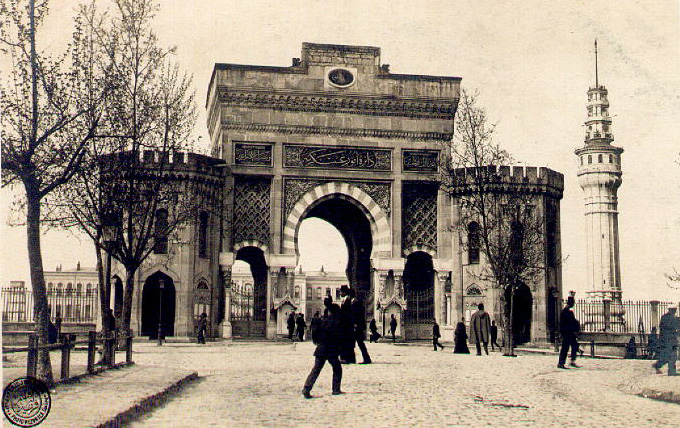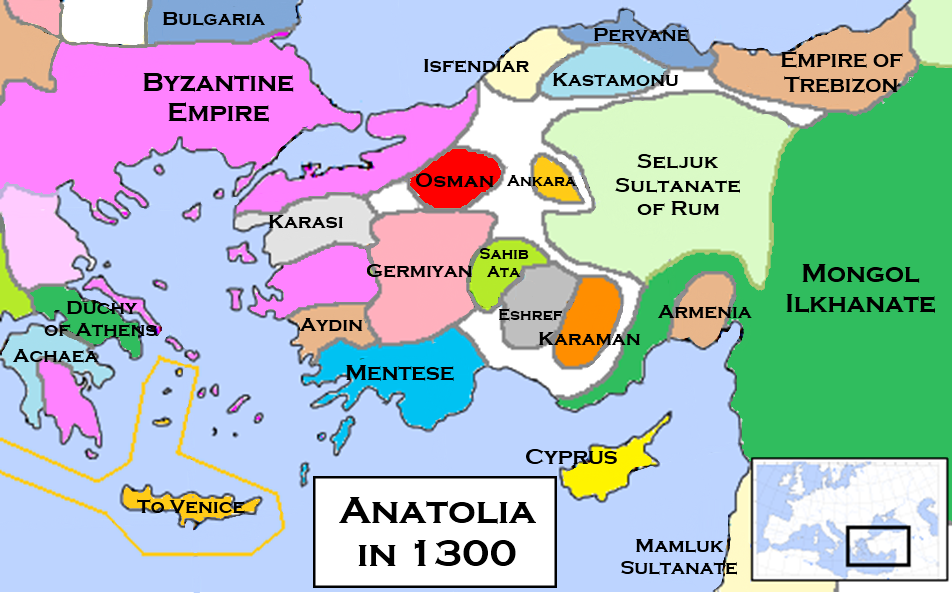|
Outline Of The Ottoman Empire
The following outline is provided as an overview of and topical guide to the Ottoman Empire: Ottoman Empire – historical Muslim empire that lasted from c. 1299 to 1922. It was also known by its European contemporaries as the Turkish Empire or Turkey after the principal ethnic group. At its zenith from the sixteenth to eighteenth centuries it controlled Southeast Europe, Southwest Asia and North Africa. General history Main periods * Rise of the Ottoman Empire * Classical Age of the Ottoman Empire * Transformation of the Ottoman Empire * Territorial evolution of the Ottoman Empire * Ottoman ancien régime * Decline and modernization of the Ottoman Empire * Defeat and dissolution of the Ottoman Empire * Partition Subperiods * Ottoman Interregnum * Sultanate of Women * Köprülü era * Tulip period * Tanzimat era * 1st Constitutional Era * 2nd Constitutional Era Historiography * Ottoman Decline Thesis * Ghaza thesis * Renegade thesis * Historiography of ... [...More Info...] [...Related Items...] OR: [Wikipedia] [Google] [Baidu] |
Köprülü Era
The Köprülü era () (c. 1656–1703) was a period in which the Ottoman Empire's politics were frequently dominated by a series of grand viziers from the Köprülü family. The Köprülü era is sometimes more narrowly defined as the period from 1656 to 1683, as it was during those years that members of the family held the office of grand vizier uninterruptedly, while for the remainder of the period they occupied it only sporadically. The Köprülüs were generally skilled administrators and are credited with reviving the empire's fortunes after a period of military defeat and economic instability. Numerous reforms were instituted under their rule, which enabled the empire to resolve its budget crisis and stamp out factional conflict in the empire. Köprülü Mehmed Pasha The Köprülü rise to power was precipitated by a political crisis resulting from the government's financial struggles combined with a pressing need to break the Venetian blockade of the Dardanelles in the ... [...More Info...] [...Related Items...] OR: [Wikipedia] [Google] [Baidu] |
Ottoman Turkish Language
Ottoman Turkish (, ; ) was the standardized register (sociolinguistics), register of the Turkish language in the Ottoman Empire (14th to 20th centuries CE). It borrowed extensively, in all aspects, from Arabic and Persian language, Persian. It was written in the Ottoman Turkish alphabet. Ottoman Turkish was largely unintelligible to the less-educated lower-class and to rural Turks, who continued to use ("raw/vulgar Turkish"; compare Vulgar Latin and Demotic Greek), which used far fewer foreign loanwords and is the basis of the modern standard. The Tanzimat, Tanzimât era (1839–1876) saw the application of the term "Ottoman" when referring to the language ( or ); Modern Turkish uses the same terms when referring to the language of that era ( and ). More generically, the Turkish language was called or "Turkish". History Historically, Ottoman Turkish was transformed in three eras: * (Old Ottoman Turkish): the version of Ottoman Turkish used until the 16th century. It wa ... [...More Info...] [...Related Items...] OR: [Wikipedia] [Google] [Baidu] |
Science And Technology In The Ottoman Empire
During its 600-year existence, the Ottoman Empire made significant advances in science and technology, in a wide range of fields including mathematics, astronomy and medicine. The Islamic Golden Age was traditionally believed to have ended in the thirteenth century, but has been extended to the fifteenth George Saliba (1994), ''A History of Arabic Astronomy: Planetary Theories During the Golden Age of Islam'', pp. 245, 250, 256–257, New York University Press, and sixteenth Ahmad Y HassanFactors Behind the Decline of Islamic Science After the Sixteenth Century/ref> centuries by some, who have included continuing scientific activity in the Ottoman Empire in the west and in Persia and Mughal India in the east. Education Advancement of madrasah The madrasah education institution, which first originated during the Seljuk period, reached its highest point during the Ottoman reign.İnalcık, Halil. 1973. "Learning, the Medrese, and the Ulema." In ''The Ottoman Empire: The Clas ... [...More Info...] [...Related Items...] OR: [Wikipedia] [Google] [Baidu] |
Culture Of The Ottoman Empire
The culture of the Ottoman Empire evolved over several centuries as the ruling administration of the Turkish peoples, Turks absorbed, adapted and modified the various native cultures of conquered lands and their peoples. There was influence from the customs and languages of nearby Islamic culture, Islamic societies such as Jordan, Egypt and Palestine, while Persian people, Persian culture had a significant contribution through the Great Seljuq Empire, Seljuq Turks, the Ottoman Turks, Ottomans' predecessors. Despite more recent amalgamations, the Ottoman dynasty, like their predecessors in the Sultanate of Rum and the Seljuk Empire were influenced by Persian culture, language, habits, customs and cuisines.Throughout its history, the Ottoman Empire had substantial subject populations of Rum Millet, Orthodox subjects, Armenians in the Ottoman Empire, Armenians, History of the Jews in Turkey#Ottoman era, Jews and Assyrians and Syriacs in Turkey, Assyrians, who were allowed a certain amo ... [...More Info...] [...Related Items...] OR: [Wikipedia] [Google] [Baidu] |
Social Structure In The Ottoman Empire
Social organisms, including human(s), live collectively in interacting populations. This interaction is considered social whether they are aware of it or not, and whether the exchange is voluntary or not. Etymology The word "social" derives from the Latin word ''socii'' ("allies"). It is particularly derived from the Italian ''Socii'' states, historical allies of the Roman Republic (although they rebelled against Rome in the Social War of 91–87 BC). Social theorists In the view of Karl Marx,Morrison, Ken. ''Marx, Durkheim, Weber. Formations of modern social thought'' human beings are intrinsically, necessarily and by definition social beings who, beyond being "gregarious creatures", cannot survive and meet their needs other than through social co-operation and association. Their social characteristics are therefore to a large extent an objectively given fact, stamped on them from birth and affirmed by socialization processes; and, according to Marx, in producing and reproduci ... [...More Info...] [...Related Items...] OR: [Wikipedia] [Google] [Baidu] |
State Organization Of The Ottoman Empire
The Ottoman Empire developed over the years as a despotism with the Sultan as the supreme ruler of a centralized government that had an effective control of its provinces, officials and inhabitants. Wealth and rank could be inherited but were just as often earned. Positions were perceived as titles, such as viziers and '' aghas''. Military service was a key to many problems. The expansion of the Empire called for a systematic administrative organization that developed into a dual system of military ("Central Government") and civil administration ("Provincial System") and developed a kind of separation of powers: higher executive functions were carried out by the military authorities and judicial and basic administration were carried out by civil authorities. Outside this system were various types of vassal and tributary states. Most of the areas ruled by the Ottomans were explicitly mentioned in the official full style of the sultan, including various lofty titles adopted to ... [...More Info...] [...Related Items...] OR: [Wikipedia] [Google] [Baidu] |
Economic History Of The Ottoman Empire
The economic history of the Ottoman Empire covers the period 1299–1923. Trade, agriculture, transportation, and religion made up the Ottoman Empire's economy. The Ottomans saw military expansion of currency, more emphasis on manufacturing and industry in the wealth-power-wealth equation, and moving towards capitalist economics comprising expanding industries and markets. They continued along the trajectory of territorial expansion, traditional monopolies, buildings, and agriculture. Transportation 16th, 17th, and 18th centuries Trade has always been an important aspect of an economy. It was no different in the 17th century. As the Ottoman Empire expanded, it started gaining control of important trade routes. The capture of Constantinople (1453) to the Ottoman Turks was a key event. Along with their victory, they now had significant control of the Silk Road, which European countries used to trade with Asia. While many sources state that the Ottoman Empire “blocked” the ... [...More Info...] [...Related Items...] OR: [Wikipedia] [Google] [Baidu] |
Historiography Of The Fall Of The Ottoman Empire
The historiography of the Ottoman Empire refers to the studies, sources, critical methods and interpretations used by scholars to develop a history of the Ottoman Dynasty's empire. Scholars have long studied the Empire, looking at the causes for its formation (such as the Ghaza thesis), its relations to the Great Powers (such as Sick man of Europe) and other empires (such as Transformation of the Ottoman Empire), and the kinds of people who became imperialists or anti-imperialists (such as the Young Turks), together with their mindsets. The history of the breakdown of the Empire (such as Ottoman decline thesis) has attracted scholars of the histories of the Middle East (such as Partition of the Ottoman Empire), and Greece (Rise of nationalism in the Ottoman Empire). Formulable theses Those about the emergence of the Ottoman Empire # Ghaza thesis — it is formulated first, but it is the most criticized and politicized. The thesis most clearly advocates the ethnic pan-Turki ... [...More Info...] [...Related Items...] OR: [Wikipedia] [Google] [Baidu] |
Ghaza Thesis
The Ghaza or Ghazi thesis (from , ''ġazā'', "holy war", or simply "raid") is a since disputed historical paradigm first formulated by Paul Wittek which has been used to interpret the nature of the Ottoman Empire during the earliest period of its history, the fourteenth century, and its subsequent history. The thesis addresses the question of how the Ottomans were able to expand from a small principality on the frontier of the Byzantine Empire into a centralized, intercontinental empire. According to the Ghaza thesis, the Ottomans accomplished this by attracting recruits to fight for them in the name of Islamic holy war against the non-believers. Such a warrior was known in Ottoman Turkish as a '' ghazi'', and thus this thesis sees the early Ottoman state as a "Ghazi State," defined by an ideology of holy war. The Ghaza thesis dominated early Ottoman historiography throughout much of the twentieth century before coming under increasing criticism beginning in the 1980s. Histor ... [...More Info...] [...Related Items...] OR: [Wikipedia] [Google] [Baidu] |
Second Constitutional Era (Ottoman Empire)
The Second Constitutional Era (; ) was the period of restored parliamentary rule in the Ottoman Empire between the 1908 Young Turk Revolution and the 1920 retraction of the constitution, after the dissolution of the Chamber of Deputies (Ottoman Empire), Chamber of Deputies, during the Dissolution of the Ottoman Empire, empire's twilight years. Alternative end dates for era include 1912 Ottoman coup d'état, 1912 or 1913 Ottoman coup d'état, 1913. The rule of Sultan Abdul Hamid II, Abdulhamid II had been opposed by the Young Turks, an underground movement of reformists which called for the restoration of constitutional monarchy. In 1908, a faction within the Young Turks called the Committee of Union and Progress (CUP) forced Abdulhamid II to restore the Ottoman constitution of 1876, liberal constitution of 1876 and the General Assembly in the Young Turk Revolution. Abdulhamid II had previously suspended the parliament and constitution in 1878, two years after they had been introduc ... [...More Info...] [...Related Items...] OR: [Wikipedia] [Google] [Baidu] |






